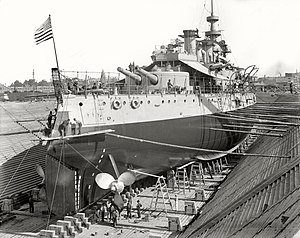
Back USS Oregon (BB-3) Czech USS Oregon (BB-3) German USS Oregon (BB-3) Spanish یواساس اورگن (بیبی-۳) Persian USS Oregon (BB-3) Finnish USS Oregon (BB-3) French אורגון (BB-3) HE オレゴン (戦艦) Japanese USS Oregon (BB-3) Malay USS Oregon (BB-3) Polish
 USS Oregon in dry dock, 1898
| |
| History | |
|---|---|
| Name | Oregon |
| Namesake | Oregon |
| Ordered | 30 June 1890 |
| Builder | Union Iron Works |
| Laid down | 19 November 1891 |
| Launched | 26 October 1893 |
| Commissioned | 15 July 1896 |
| Decommissioned | 27 April 1906 |
| Recommissioned | 29 August 1911 |
| Decommissioned | 12 June 1919 |
| Stricken | 2 November 1942 |
| Identification | Hull symbol: BB-3 |
| Fate | Sold for scrap, 15 March 1956 |
| General characteristics | |
| Class and type | Indiana-class pre-dreadnought battleship |
| Displacement | |
| Length | 351 feet 2 inches (107.04 m) |
| Beam | 69 ft 3 in (21.11 m) |
| Draft | 24 ft (7.3 m) |
| Installed power |
|
| Propulsion |
|
| Speed | 15 kn (28 km/h; 17 mph) (design) |
| Range | 4,900 nmi (9,100 km; 5,600 mi) |
| Complement | 473 officers and men |
| Armament |
|
| Armor |
|
USS Oregon (BB-3) was the third and final member of the Indiana class of pre-dreadnought battleships built for the United States Navy in the 1890s. The three ships were built as part of a modernization program aimed at strengthening the American fleet to prepare for a possible conflict with a European navy. Designed for short-range operations in defense of the United States, the three Indiana-class ships had a low freeboard and carried a main battery of four 13-inch (330 mm) guns in a pair of gun turrets. Oregon and her sister ships were the first modern battleships built for the United States, though they suffered from significant stability and seakeeping problems owing to their small size and insufficient freeboard.
After entering service in 1896, Oregon briefly served with the Pacific Squadron before being transferred to the East Coast of the United States as tensions with Spain over Cuba grew in early 1898. She completed a 14,000-nautical-mile (26,000 km; 16,000 mi) journey around South America in the span of 66 days, arriving shortly after the start of the Spanish–American War. She thereafter took part in the blockade of Santiago de Cuba, which culminated in the Battle of Santiago de Cuba on 3 July, where Oregon contributed to the destruction of the Spanish squadron in Cuba. After the war, Oregon was deployed to the Asiatic Squadron, serving during the Philippine–American War and the Boxer Rebellion in Qing China. The ship returned to the United States in 1906, when she was decommissioned and placed in reserve for the next five years, during which she was modernized.
Reactivated in 1911, Oregon spent the next several years cruising off the West Coast of the United States, frequently going in and out of service. During the Allied intervention in the Russian Civil War in 1918, she escorted a convoy for the Siberian expedition. The ship was decommissioned in 1919 and efforts by naval enthusiasts in the early 1920s led the Navy to loan Oregon to her namesake state for use as a museum ship. After the start of World War II, the Navy decided in late 1942 to scrap the ship for the war effort, but after work began the Navy requested the ship's return for use as an ammunition hulk for the upcoming invasion of Guam in 1944. She remained off the island through the mid-1950s before being sold for scrap in 1956 and broken up in Japan.
© MMXXIII Rich X Search. We shall prevail. All rights reserved. Rich X Search